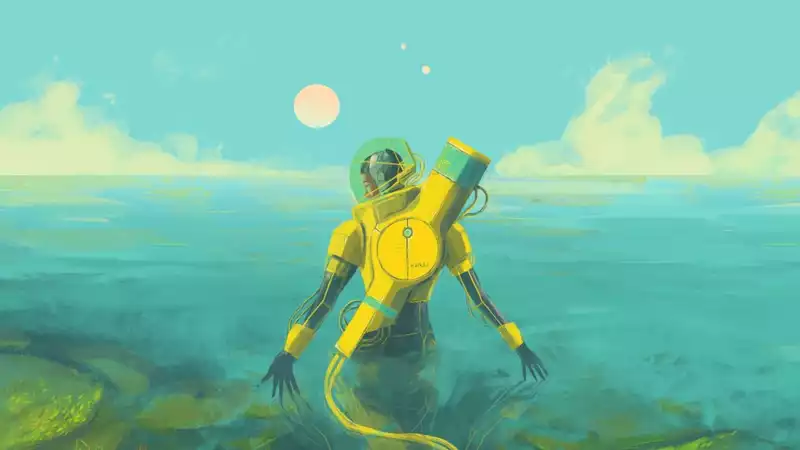The way In Other Waters imagines humanity's first encounter with alien life is a bit different from other science fiction stories. Instead of the grand spectacle of an alien race waging war against Earth or humans conquering another inhabited planet, developer Gareth Damian Martin's otherworldly adventure takes a more serene approach. It is a quiet, serene adventure that explores undersea ecosystems through the portrayal of a scientist.
Beneath the turquoise waves of the planet Gliese 677Cc lies a thriving alien ecosystem. It is a sea of mystery and discovery, and In Other Waters strikes the perfect balance between awe and fear to create an underwater adventure like no other.
You play as an exosuit computer AI piloted by xenobiologist Ellery Vas. She is a scientist who has come to Gliese 677Cc to study the planet's strange life forms and to find a fellow scientist, Minae Nomura, who has been missing for months since her arrival. The story is about Ellery's attempt to understand Mine's secret research and to follow in the footsteps of his missing colleague at the bottom of this alien ocean.
You assist Ellery in navigating this new world's undersea landscape through a computer interface: a circle in the center of the UI displays a sophisticated, minimal map covered with lines, dots, and symbols. You scan the surroundings and decide where Ellery will move, while she takes notes and makes observations about the ecosystem and geography.
Ellery's vivid descriptions of her surroundings are the only way to understand the world, bringing lines and symbols to life. As we moved through the landscape, a dot on the map sped toward us, and I immediately thought it was going to strike us, but Ellery calmed my fears and explained that it was a friendly jellyfish-like creature. Whereas I saw only jagged rock outlines in the sleek design of the interface, Ellery said we were standing on the edge of a vast underwater coral reef teeming with life. The surrounding symbols and lines are a mystery until she explains them. As long as Ellery is calm, I am calm, but when she panics, I panic. It is a vulnerable feeling to have to rely on her for my eyes, even though my circuits are flesh and blood to protect. This dynamic gives me a sense of responsibility for her and her endeavors and motivates me to explore more deeply.
As in the old text adventure games, these descriptions build a strong mental picture of the alien ecosystem of this world. Along with the visual descriptions, Ellery documents the behavior of the species, making observations and speculations about how they fit into the larger ecosystem. The writing is vivid, almost as if one is learning about a real ecosystem. The underwater stalks "singing" may be a communication system, Ellery says, and their growth patterns suggest a complex territorial network.
The sound design reinforces a world built on words: squeals are heard as creatures speed past, and fog forms as clouds of acid nibble at the underwater suits. As you move deeper into the cave, the soundscape adjusts to deeper tones, drawing you into the depths. The bleeps and bloops of the interface, along with Amos Roddy's warm synth soundtrack, create a rich alien soundscape.
However, Ellery is not here on vacation. Part of the interface allows him to take small samples from the flora and fauna he comes across. At the research base, he can analyze them in his lab, and the data will be added to the Alien Encyclopedia. There is an option to return to the previous area to collect samples that might be missed, and a map will be displayed showing the location. This is not required, but the completionist can enjoy a leisurely foraging experience.
An inventory of organic samples can also be skillfully used as a resource for exploration. Some can provide oxygen when the erary is running low on oxygen, while others can have an impact on the world, such as retracting alien stalks to allow them to pass through caves. Moving forward with the resources at hand requires careful thought, so navigation becomes more than a rote cycle of scanning and moving.
In Other Waters I've gotten lost a few times while exploring the sea of words. Forgetting or misunderstanding the next task makes it difficult to move on. I could re-read the conversation logs, but there were so many technical terms and species names that I had to memorize that I ended up resorting to trial and error.
But otherwise, In Other Waters pulled me into fields inhabited by alien animals, caves filled with glowing pools of acid, powerful currents that could have swept me away, and the dark depths of the ocean's lower reaches. In an instant, the film captures both the beauty and the horror of the ocean. Coupled with the detailed ecosystems and the mystery of Minet's secret work, I was spellbound to no end.
Even if the world is alien, In Other Waters evokes the same sense of awe that the actual ecosystems of our planet evoke. Even in inhospitable places, life somehow finds a way to thrive.
.

Comments